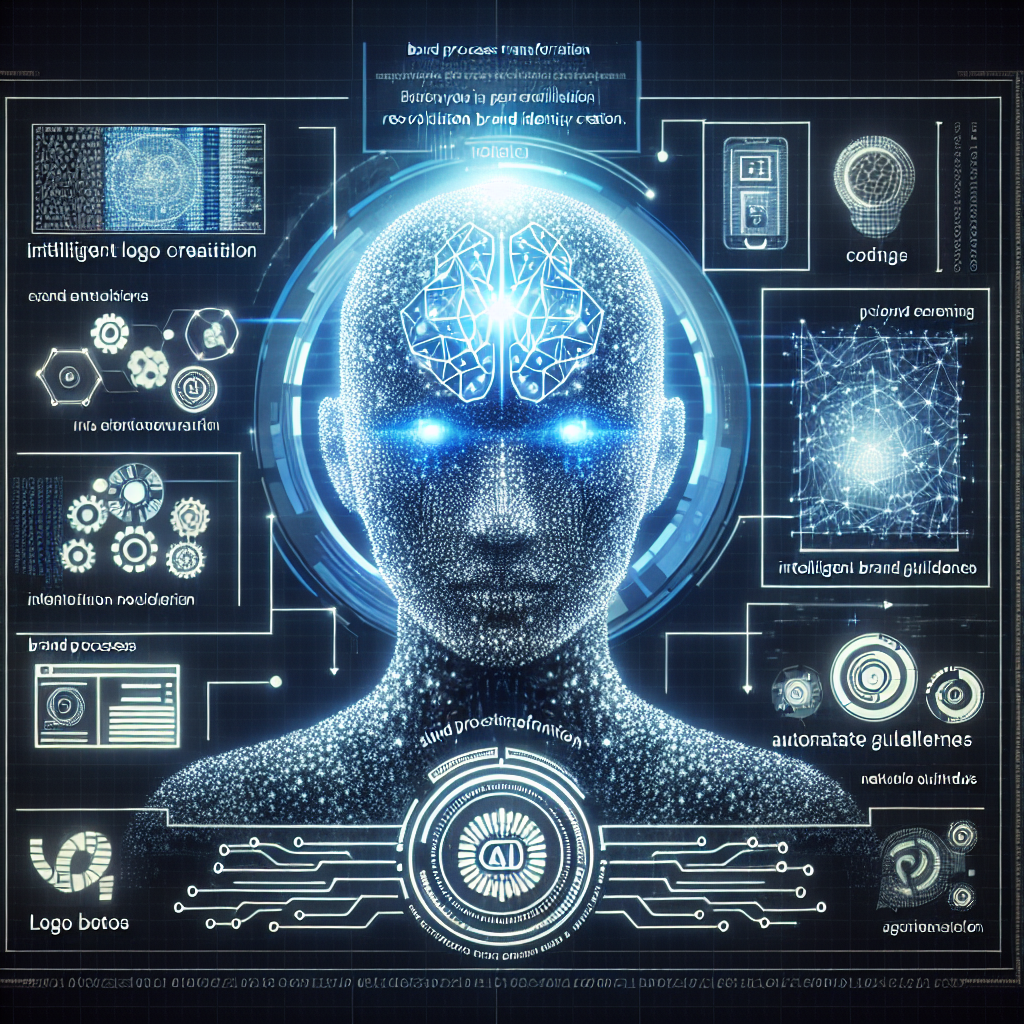AI Elements In Brand Identity. Step into the future of brand identity with the infusion of AI elements. As technology continues to advance at a rapid pace, businesses are finding innovative ways to incorporate artificial intelligence into their branding strategies. From intelligent chatbots that provide personalized customer experiences, to sophisticated algorithms that analyze big data for insights, AI is revolutionizing the way brands connect with their audience. By harnessing the power of AI, companies can create distinct and memorable brand identities that captivate and engage consumers in ways never before imagined. Get ready to explore the fascinating world where AI and brand identity converge and open up an abundance of possibilities.
The Role of AI in Brand Identity
In today’s fast-paced and highly competitive business landscape, establishing a strong brand identity is crucial for success. With the rapid advancement of technology, specifically artificial intelligence (AI), businesses have found innovative ways to enhance their brand recognition, personalize brand experiences, improve customer engagement, leverage data-driven insights, and even power their brand storytelling initiatives. In this article, we will explore the various ways AI is revolutionizing brand identity.
Enhancing brand recognition through AI
AI has become an invaluable tool in enhancing brand recognition. One of the key areas where AI is making a significant impact is in logo design. Using AI algorithms, businesses can create unique and memorable logos that capture the essence of their brand. By analyzing various elements such as color psychology, shape and form, and historical logo trends, AI can generate visually striking logos that resonate with target audiences.
Personalizing brand experiences with AI
Another area where AI is transforming brand identity is through personalized experiences. AI algorithms have the ability to analyze vast amounts of data, including customer behavior and preferences, to deliver tailored experiences. By leveraging AI, businesses can create personalized interactions at every touchpoint, whether it’s through email marketing, website recommendations, or chatbots. This level of personalization not only enhances the overall customer experience but also increases brand loyalty and advocacy.
Improving customer engagement with AI
AI’s influence extends beyond personalization and also plays a vital role in improving customer engagement. By utilizing natural language processing (NLP) and sentiment analysis algorithms, businesses can understand customer sentiment and preferences better. AI-powered chatbots and virtual assistants can provide real-time responses and assistance, ensuring efficient and personalized customer service. This level of engagement fosters a positive brand perception and sets businesses apart from the competition.
Leveraging AI for data-driven insights
Data-driven insights are crucial in making informed business decisions, and AI has become an indispensable tool in this area. AI algorithms can analyze large datasets and extract valuable insights regarding consumer trends, market preferences, and brand sentiment. By leveraging this information, businesses can optimize their marketing strategies and tailor their campaigns to suit specific target audiences. This data-driven approach ensures that decisions are well-informed and result in a more impactful brand identity.
AI-powered brand storytelling
Storytelling is an essential aspect of brand identity, and AI is revolutionizing how brands tell their stories. By analyzing vast amounts of data, including social media posts, customer reviews, and historical data, AI algorithms can generate compelling narratives that resonate with audiences. Whether it’s through personalized emails, social media campaigns, or website content, AI can create engaging and relevant stories that captivate consumers and strengthen brand perception.
AI in Logo Design
Using AI to create unique and memorable logos
Logo design is a crucial aspect of brand identity, and AI is transforming the way logos are created. By analyzing various design trends, color psychology, and historical logo data, AI algorithms can generate visually striking and unique logos that are tailor-made for specific brands. This AI-powered approach ensures that logos are not only visually appealing but also capture the essence and values of a brand, leaving a lasting impression on consumers.
Automated logo generation with AI
Traditionally, logo design has been a time-consuming process that involves multiple iterations and revisions. However, with AI, businesses can automate the logo generation process. By inputting specific requirements and design preferences, AI algorithms can quickly generate a range of logo options that meet the desired criteria. This streamlines the logo design process, saving time and resources while still ensuring high-quality and professional designs.
Streamlining the logo design process using AI
With AI, the logo design process can be streamlined, allowing businesses to create logos efficiently and effectively. AI algorithms can analyze the target audience, industry trends, and competitor logos to generate initial logo concepts. Designers can then use these concepts as a starting point, refining and iterating until the final logo design is achieved. This collaborative approach between AI and human designers maximizes the creative potential while saving time and effort.

AI in Typography
Customizing typography with AI
Typography plays a significant role in brand identity, and AI can be used to customize typefaces to suit specific brands. By analyzing a brand’s values, personality, and target audience, AI algorithms can generate customized typography options that reflect the desired characteristics. This level of customization ensures that the typography aligns with the overall brand identity, creating a cohesive and visually appealing brand experience.
Generating new typefaces with AI
AI can also push the boundaries of typography by generating entirely new typefaces. By analyzing existing typefaces, historical fonts, and design principles, AI algorithms can create unique and innovative typefaces that are one-of-a-kind. This level of creativity allows brands to stand out and differentiate themselves in the market, leaving a lasting impression on consumers.
Enhancing readability and legibility with AI
AI algorithms can also enhance readability and legibility in typography. By analyzing various factors such as letter spacing, line height, and font weight, AI can optimize the typography for improved legibility across different mediums, including websites, mobile apps, and print materials. This attention to detail ensures that the brand’s message is conveyed effectively and that users have a seamless reading experience.
AI in Color Selection
Leveraging AI to choose brand colors
Color selection is a critical component of brand identity, and AI can assist in choosing the most suitable colors. By analyzing color psychology, cultural associations, and industry trends, AI algorithms can generate color palettes that align with a brand’s values and target audience. This level of precision and data-driven approach ensures that the chosen colors evoke the desired emotions and resonate with consumers.
Predicting color trends with AI
AI can also be used to predict color trends, allowing brands to stay ahead of the curve. By analyzing vast amounts of data from social media, fashion trends, and industry developments, AI algorithms can identify emerging color trends and patterns. Armed with this information, brands can proactively update their color palettes and maintain a modern and relevant brand identity.
Creating color palettes with AI
AI can streamline the process of creating color palettes by automating the selection and combination of colors. By inputting specific requirements and preferences, AI algorithms can generate a range of color palettes that align with a brand’s identity. Designers can then choose the most suitable palette, ensuring consistency and cohesiveness in visual communication.

AI in Visual Identity Systems
Automating brand identity systems with AI
Visual identity systems are complex and require meticulous attention to detail. AI can automate various aspects of brand identity systems, such as logo placement, color usage, and typography guidelines. By applying AI algorithms, businesses can ensure consistency across different touchpoints, including websites, packaging, and marketing collateral. This automation saves time and reduces the risk of human error, resulting in a streamlined and cohesive brand identity.
Optimizing consistency across different touchpoints with AI
Consistency is key when it comes to brand identity, and AI can help optimize consistency across different touchpoints. By analyzing various design assets and brand guidelines, AI algorithms can ensure that visual elements, such as the logo, typography, and color palette, are consistently applied across different mediums. This level of consistency builds brand recognition and familiarity, reinforcing brand identity in the minds of consumers.
Evolving visual identity with AI as the brand grows
As a brand evolves and expands, its visual identity needs to adapt accordingly. AI can play a crucial role in this process by analyzing market trends, consumer preferences, and design principles to evolve the visual identity seamlessly. Through AI-powered algorithms, businesses can identify areas of improvement, generate new creative concepts, and refine the visual identity as the brand grows.
AI in Voice and Tone
Crafting brand voice and tone with AI
Brand communication is not just about visual elements but also about voice and tone. AI can assist in crafting the brand’s voice and tone by analyzing existing content, customer feedback, and industry best practices. AI algorithms can generate suggestions for language, vocabulary, and style that align with the desired brand identity. This AI-powered approach ensures consistent and coherent brand messaging across different communication channels.
Using AI to adapt brand communication to different channels
Different communication channels require different approaches, and AI can help adapt brand communication accordingly. By analyzing the nuances of each channel, including social media, email, and customer support, AI algorithms can generate communication strategies that are tailored to each medium. This level of adaptability ensures that the brand’s voice and tone remain consistent while still resonating with the unique characteristics of each channel.
Maintaining consistency in brand messaging with AI
Consistency is crucial in brand messaging, particularly when there are multiple team members involved. AI can assist in maintaining consistency by providing guidelines and suggestions for language usage across different communication materials. By leveraging AI-powered tools, businesses can ensure that the brand messaging remains cohesive and aligned with the desired brand identity.
AI in Photography and Imagery
Enhancing imagery with AI-powered editing tools
Photography and imagery play a significant role in brand identity, and AI-powered editing tools can enhance these visuals. AI algorithms can analyze and optimize various aspects of imagery, including lighting, composition, and color correction. By using AI-powered tools, businesses can ensure that the visual content represents the brand identity accurately and is visually appealing to consumers.
Automating image selection based on brand guidelines
AI can also automate the process of selecting images that align with the brand guidelines. By analyzing various parameters such as subject matter, composition, and color palette, AI algorithms can identify images that are a perfect fit for the brand’s visual identity. This automation saves time and effort in manually searching and selecting images, ensuring that visual content remains consistent and aligned with the brand.
Creating personalized visual content with AI
Personalization is a growing trend in marketing, and AI can help create personalized visual content. By analyzing customer data, preferences, and behavior, AI algorithms can generate imagery that is tailored to each individual customer. Whether it’s personalized product recommendations or targeted advertising, this level of personalization enhances the overall brand experience and strengthens brand loyalty.
AI in Social Media Strategy
Leveraging AI for social media analytics and insights
Social media is a valuable platform for brand identity, and AI can amplify its impact through analytics and insights. AI algorithms can analyze vast amounts of social media data, including engagement metrics, sentiment analysis, and demographic information. By leveraging this data, businesses can optimize their social media strategies, identify areas for improvement, and maximize the impact of their brand identity.
Using AI to optimize social media advertising
AI can also optimize social media advertising campaigns. By analyzing user behavior, preferences, and historical performance data, AI algorithms can generate targeted and personalized advertisements that resonate with specific audiences. This level of optimization ensures that social media advertising effectively communicates the brand identity and generates a higher return on investment.
Automating social media content creation with AI
Social media content creation can be a time-consuming process, but AI can automate this task. AI algorithms can generate content ideas, write captions, and even create visuals that are tailored to each social media platform. This automation saves time and resources while still ensuring a consistent brand presence across different social media channels.
AI in Brand Monitoring
Monitoring brand sentiment with AI
Monitoring brand sentiment is crucial for maintaining a positive brand image, and AI can assist in this task. AI algorithms can analyze social media posts, customer reviews, and online conversations to gauge the sentiment towards a brand. By monitoring this sentiment in real-time, businesses can identify potential issues and address them promptly, ensuring a positive brand perception.
Identifying and addressing potential brand risks with AI
AI can also help businesses identify and address potential brand risks. By analyzing various sources, including news articles, social media posts, and online forums, AI algorithms can detect early signs of negative sentiment or brand risks. This early detection allows businesses to take proactive measures to mitigate any potential damage to their brand identity.
Automating brand monitoring tasks with AI
Brand monitoring is an ongoing task that requires constant attention, but AI can automate many aspects of this process. By leveraging AI-powered tools, businesses can automate data collection, analysis, and reporting, saving time and resources. This automation ensures that brand monitoring remains efficient and comprehensive, allowing businesses to stay vigilant and protect their brand identity.
Ethical Considerations of AI in Brand Identity
Ensuring transparency and accountability in AI usage
As AI becomes more integrated into brand identity, it is essential to ensure transparency and accountability in its usage. Businesses must be transparent about their use of AI and clearly communicate how it impacts their brand identity. Additionally, ethical guidelines should be established to ensure that AI is used responsibly and in alignment with ethical standards.
Addressing bias and discrimination in AI-powered brand identity
AI algorithms are only as unbiased as the data they are trained on, and there is a risk of bias and discrimination in AI-powered brand identity. It is crucial for businesses to address this issue by ensuring that the training data is diverse and representative. Regular monitoring and auditing of the AI systems can help identify and rectify any biases, ensuring fairness and inclusivity in brand identity.
Balancing automation with human creativity and judgment
While AI offers various benefits in brand identity, it is essential to strike a balance between automation and human creativity and judgment. AI should be seen as a tool that enhances human creativity rather than replacing it. Human designers and marketers play a crucial role in shaping brand identity, and AI should complement their work, allowing them to focus on strategic and creative aspects.
Embracing AI in brand identity can lead to exciting possibilities and opportunities for businesses. From enhancing brand recognition and personalizing experiences to optimizing social media strategies and monitoring brand sentiment, AI has the potential to revolutionize how brands connect with their audiences. However, it is vital to approach AI implementation ethically and responsibly to ensure a positive and impactful brand identity in the digital age.
